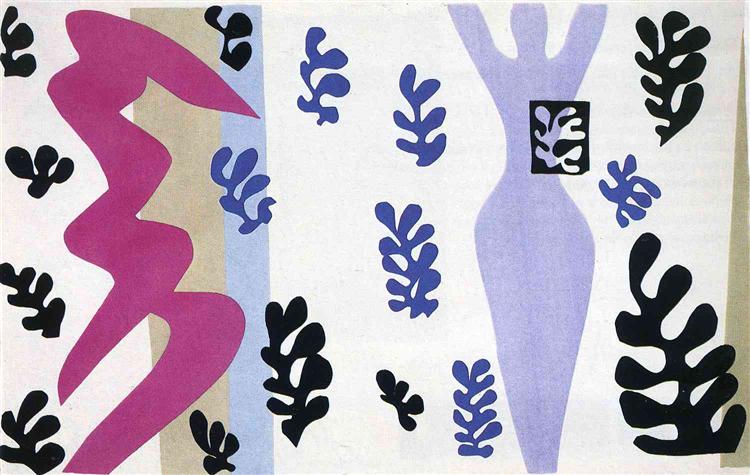Description
Henri Matisse, master indisputable of Fauvism and a central figure of modern art, presents us in "The Knife Thrower" (1947) a work that encapsulates his unparalleled ability to fuse visual elements with sublime chromatic exuberance. The painting, measuring 75x48 cm, is a vivid testimony to Matisse's constant drive to explore and reinvent the pictorial language, even in the most advanced stages of his artistic career.
Upon closely inspecting "The Knife Thrower," we find ourselves facing a composition that, although seemingly simple, unfolds a complexity of shapes and colors that incites reflection. The central figure of the knife thrower stands out against a monochromatic blue background, allowing the silhouettes and shapes to be captured more clearly by the viewer's eye. The character, represented with an almost schematic stroke, seems to be immersed in a performative act, holding the knives ready to throw, which infuses the scene with a dynamic sense and latent tension.
The chromatic choice is, without a doubt, one of the greatest strengths of this painting. Matisse employs color with a characteristic boldness, typical of someone who understands the psychological potential of each tone. The knives, despite being objects of a cold and threatening nature, are outlined with colors that vibrate and radiate a lively energy. This transforms what could be a moment of danger into a vibrant and almost poetic visual choreography.
It is also necessary to pay attention to how Matisse uses negative space in "The Knife Thrower." The simplicity of the background is not mere absence but a deliberate choice that emphasizes the action and gives the event an almost theatrical magnitude. Each element positioned on the canvas seems to be calculated to maintain a balance and harmony that evokes classical tradition, but subverted with bold modernity.
It is notable how the work is inserted into the context of Matisse's artistic journey. In the 1940s, the artist had already experimented with cutouts and collages, which translates here into flat forms and defined contours. Additionally, Matisse was in the midst of exploring themes involving figures in motion and everyday scenes reinterpreted through his unique vision. "The Knife Thrower," in this way, is not just a static image but a fragment of a story in which the artist captures the essence of circus practice as a metaphor for balance and precision.
Matisse's work has always stood out for its ability to transform the ordinary into the extraordinary, and "The Knife Thrower" is a clear example of this. Through a bold palette and an impeccably balanced composition, Matisse invites us to observe, feel, and participate in the suspended act of the knife thrower. Here, the apparent simplicity is a door to the complexity of emotions and meanings that the master Frenchman knew how to imprint in each of his creations.

